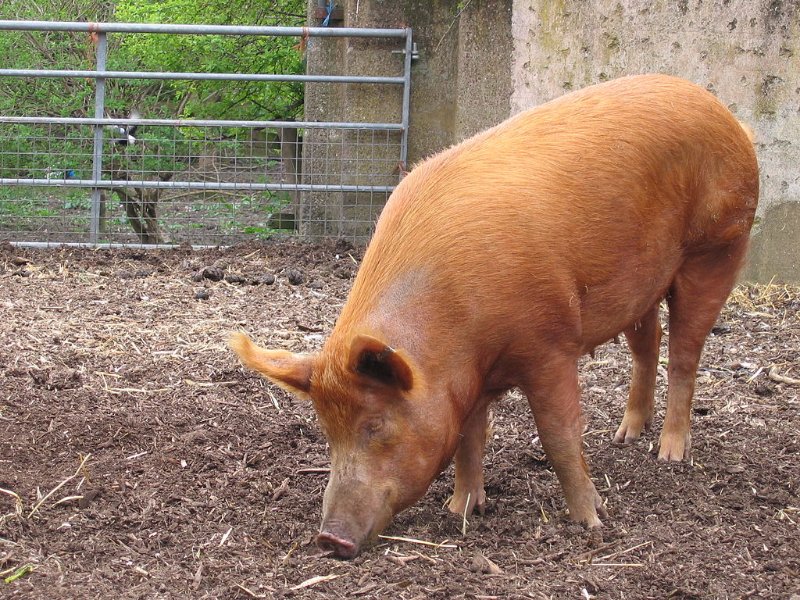Mon, Aug 6, 2018
Article may contain affiliate links. As an Amazon Associate I earn from qualifying purchases.
 Tamworth Pig / Caroline Ford / CC-BY-SA-3.0
Tamworth Pig / Caroline Ford / CC-BY-SA-3.0
Tamworth pigs are often overlooked as a possible addition to family farms - however, we think this is a big mistake.
It’s no secret that hobby and family farmers are often overworked. There are just not enough hours in the day to get everything done.
What if there was a pig that offered great tasting, lean meat and was practically self-sufficient? That would be pretty great, right?
Enter the Tamworth pig.
Here are the top 7 characteristics of Tamworth pigs that make this breed is a great addition to most family farms.
1. Tender, Lean Meat
Tamworth pigs are considered a great bacon breed because they have tender and lean meat.
Unlike other bacon pigs, the Tamworth breed is less fatty. This is primarily due to the fact that they eat low energy foods, are very active and tend to grow more slowly than other bacon breeds.
A Tamworth pig is ready for slaughter after 25 to 30 weeks and will weigh 500 to 600 pounds at maturity.
If high-quality, good tasting meat is important to you, then a Tamworth is a great choice for most family farms.
2. Hardy as Heck
It’s surprising that Tamworth pigs are not more popular since they can adapt to almost any environment. They are hardy enough to withstand cold temperatures, wind and love being active.
Their muscular build gives them the ability to walk long distances and are comfortable grazing on large pastures.
While they can withstand adverse weather, they are more vulnerable during summer months. After they molt they are susceptible to sunburns when exposed to the sun for long periods. They need sufficient shade or shelter as well as plenty of mud in the summer to keep them cool.
That being said, their coat is thick and coarse, which gives them superior sun protection over other breeds.
3. Not Raised Commercially
Due to the fact that Tamworth pigs don’t like being contained in small spaces and prefer to graze, they are not raised for commercial production. Plus, they grow slower than other breeds making them less attractive to profit-hungry corporations.
That being said, these reasons should not discourage you from adding a Tamworth to your farm. Quite the opposite, in fact.
Since they don’t like to be cooped up, they make a great addition to hobby farms that want to raise free-range pigs.
Plus, consumers are rapidly turning to farmers markets and niche meat markets to find free-range and organic meat. Adding a few Tamworth pigs to your farm could become a profitable venture once the people in your town realize how tasty it is.
4. Love to Graze
Tamworth pigs have long heads and snouts designed for foraging. They love to graze in pastures and will eat just about anything they find.
The Tamworth breed originated in central England where they would survive on their own grazing in oak and beech forests. When their diet includes acorns, some farmers believe it gives the pork a unique and desirable flavor.
Most farmers agree that Tamworth pigs can graze alongside other livestock without issue. However, it is important to remember that pigs are naturally territorial so they may need their own grazing area separate from other livestock.
5. Social and Friendly
Adding livestock to a family or hobby farm can be like adding a new member to your family. Not a decision to be taken lightly.
The good news is that Tamworth pigs are thought to have a good disposition and character. They are a social animal and thrive being around other pigs.
Of course, they will also survive on their own as long as they get plenty of attention from humans. Give them an occasional belly or back scratch and you will become their new best friend.
Although pigs are generally territorial, these are not considered predatory and will coexist with other livestock or farm animals.
6. Great for Breeding
Tamworth sows usually have 6 to 10 piglets at a time and are productive breeders. Like other breeds of pigs they can produce a few dozen piglets per year.
Tamworth piglets have a very high survivability rate compared to other breeds. This could be due to their history as a hardy breed that lived off the land.
Sows are considered great mothers because they are docile, yet protective of their young.
7. Long History
It has been said that the breed gets its name from the village of Tamworth, England. They were imported into England from Ireland by Sir Robert Peel around 1812.
They were raised in the countryside where they could graze the dense oak and beech forests. Their muscular form gave them the ability to navigate the local terrain and walk long distances.
Tamworth pigs were first imported into North America in 1882 and have been an important part of United States farming history.
Since the Tamworth breed has had a breeding history in the United States since 1925 it is considered Heritage Pork by the Livestock Conservancy.
However, due to changes to pork production after World War II favoring fast growing breeds, the Tamworth’s fate has been turbulent.
The good news is that it was recently removed from the list of threatened breeds, but it is still on the watch list.
Conclusion
If you are looking for a new addition to your farm, a Tamworth pig is a great option. Not only do they offer tender, lean meat that can’t be found in other breeds, but they are extremely hardy.
Since they are not raised commercially they offer a unique product for farmers that want to serve passionate local consumers. Tamworth pigs can be raised as free-range pigs since they love to graze and can coexist with other livestock in a pasture. Are you considering a Tamworth pig for your farm or do you have one? Share your experience with our community.
READ NEXT
